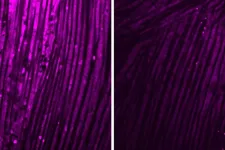(Press-News.org) Key takeaways
Landslides triggered by intense rainfall can sometimes be predicted along with incoming storms, but dry-season landslides often take people by surprise.
The July 2023 Rolling Hills Estates landslide that destroyed 12 homes seemed to come out of nowhere, but new research shows it began as early as December 2022.
Researchers are developing a database that will enable scientists to plug in new data to monitor potential landslides in real time and possibly predict them.
Californians are familiar with landslides that occur around storms, when saturated soil and rock loses its grip and slips from its perch on the substrate. These types of landslides can be triggered by intense rainfall, and incoming storms can be a warning that neighborhoods need to evacuate.
Landslides that happen during the hot, dry summers, though, tend to take people by surprise. In July 2023, for example, a landslide seemed to come out of nowhere to devastate a neighborhood in Rolling Hills Estates, located on the northern side of the Palos Verdes Peninsula in Los Angeles County.
Now, landslide researchers at UCLA and NASA’s Jet Propulsion Laboratory, or JPL, have published a paper in Geophysical Research Letters that shows that the 2023 Rolling Hills Estates event was a slow-moving, progressive landslide that began the winter before, when unusually heavy rainfall infiltrated into the slope and reduced its strength. The researchers used satellite data to measure minute shifts in the surface of the affected area before, during and after the slide and concluded that this method could be used to detect future landslides before they become catastrophic.
“Movement on the Palos Verdes Peninsula’s Portuguese Bend Landslide has been recorded since the late 1950s,” said paper co-author Alexander Handwerger, a research scientist at UCLA’s Joint Institute for Regional Earth System Science & Engineering and JPL. “But there was no discernible movement in this region of the nearby Rolling Hills Estates before 2023. People began reporting movement, as indicated by cracks in houses, in April 2023, which matches our observations. There was initial slow movement that accelerated progressively, culminating in complete collapse several months later.”
The study, led by UCLA postdoctoral researcher Xiang Li, used satellite radar and optical data taken over Los Angeles every few weeks to measure ground motion over time. The satellite radar data for Rolling Hills Estates from 2016 to July 2023 revealed that after very slight movement during the 2019 rainy season, the ground remained stable until heavy winter rainfall, starting in December 2022, kickstarted movement in February. By June, the area had moved 0.04 meters, or about 1.6 inches, and on July 8 — a sunny, dry day preceded by 40 dry days — around 10 meters, or 33 feet, of horizontal motion occurred, destroying 12 homes.
The likely reason for the delay between initial movement in February and complete failure in July is that it took time for increased instability to develop. The researchers hypothesize that as water seeped through the ground, a sliding surface formed, causing the landslide body, including the ground surface, to slide progressively until the entire landslide moved rapidly all at once.
“Formation of the sliding surface will induce some movement, while the collapse will only occur when the sliding surface is fully developed,” Li said. “The progression can happen over hours, months or years.”
The researchers then attempted to determine if the Rolling Hills Estates landslide could have been predicted. By computing the displacement over time, they arrived at a predicted failure date on July 11, three days after the real landslide on July 8. They note that although their results are encouraging, predicting landslides using satellite remote sensing data needs further refinement, and landslides in areas without good historical satellite data might not be possible to predict in this way.
Li said that one of the challenges in forecasting landslides is the time period over which the progression takes place. Accurate forecasting requires continuous historical and ongoing satellite radar or in-situ measurements.
Handwerger is a core member of a project at JPL that is building an analysis-ready surface displacement database from satellite radar data for the entire United States, U.S. territories, Canada within 200 km of the U.S. border, and all mainland countries from the southern U.S. border up to and including Panama. The project, called Observational Products for End-Users from Remote Sensing Analysis, or OPERA, will contain analysis-ready data for near real-time monitoring and, possibly, landslide prediction.
“These motions can be quite subtle before they begin to move fast,” Li said. “Cracks in structures are what people tend to notice first. In fact, local residents in Rolling Hills Estates first reported cracks in their houses starting in April 2023. Signs of active movement require caution and monitoring because they could signal a progressive failure in the future.”
END
2023 Rolling Hills Estates landslide likely began the winter before
The progressive landslide took months to develop into a catastrophe
2024-07-12
ELSE PRESS RELEASES FROM THIS DATE:
Rutgers researchers spot potential hazard with private well water treatment
2024-07-12
Systems designed to treat arsenic in private well water may be malfunctioning and endangering the health of people who count on them to keep their water safe, according to Rutgers researchers.
Megan Rockafellow-Baldoni, an assistant professor of environmental and occupational health and justice at the Rutgers School of Public Health, together with co-authors including Rutgers alum Steven Spayd, a retired research scientist formerly with the New Jersey Department of Environmental Protection, tested the water of 62 New Jersey homes with whole-house arsenic-removing water treatment systems. Their study was ...
When to trust an AI model
2024-07-12
CAMBRIDGE, MA – Because machine-learning models can give false predictions, researchers often equip them with the ability to tell a user how confident they are about a certain decision. This is especially important in high-stake settings, such as when models are used to help identify disease in medical images or filter job applications.
But a model’s uncertainty quantifications are only useful if they are accurate. If a model says it is 49% confident that a medical image shows a pleural effusion, then 49% of the time, the model should be right.
MIT ...
Research shows gamified investment sites have risks for novice investors
2024-07-12
TORONTO - What happens when online investment trading platforms start to resemble games that keep people playing for hours, with badges and exploding confetti to reward investors for their engagement?
For those who know what they’re doing, it won’t make much of a difference. New research from the University of Toronto engaging nearly 1,000 volunteers in artificial investment scenarios shows that more informational features such as price change notifications might even help savvy investors execute ...
Specially equipped natural killer cells show effectiveness against the most common form of ovarian cancer
2024-07-12
RESEARCH SUMMARY
Study Title: CAR memory-like NK cells targeting the membrane proximal domain of mesothelin demonstrate promising activity in ovarian cancer
Publication: Science Advances
Dana-Farber Cancer Institute authors include: Rizwan Romee, MD, senior author; and Mubin Tarannum, PhD, KhanhLinh Dinh, and Juliana Vergara, MD, MMSc, co-first authors
Summary: Natural killer, or NK, cells endowed with memory-like abilities and armed with a novel chimeric antigen receptor (CAR) have generated encouraging results in experiments in epithelial ovarian cancer ...
Entering the golden age for antibody-drug conjugates in gynecologic cancer
2024-07-12
“We are optimistic that the incorporation of ADCs into the treatment of aggressive tumors and treatment refractory gynecologic cancers will improve quality of life and survival outcomes in our patients.”
BUFFALO, NY- July 12, 2024 – A new editorial paper was published in Oncoscience (Volume 11) on May 20, 2024, entitled, “Entering the golden age for antibody-drug conjugates in gynecologic cancer.”
In this new editorial, researchers Michelle Greenman, Blair McNamara, Levent Mutlu, and Alessandro D. Santin from Yale University School of Medicine discuss gynecologic cancers. Biologically aggressive ...
Judge: Texas university must release records on research study that resulted in deaths of dozens of animals
2024-07-12
SAN ANGELO, Texas —Tom Green County District Court Judge Barbara L. Walther ruled Thursday, July 11, 2024, that Angelo State University must release public records relating to an experiment conducted on dozens of mice that resulted in the animals’ unnecessary suffering and death, reportedly to study the impact of the foster care system on human children.
The ruling overturns Texas Attorney General Ken Paxton’s Nov. 17, 2022 decision to side with the university in denying the records.
On July 13, 2023, the Physicians Committee for Responsible Medicine, a Washington, D.C. based health advocacy group of more than 17,000 doctor members that encourages higher standards ...
UMass Amherst food scientist rises to the challenge of giving marbled fatty feel and taste to plant-based meat
2024-07-12
One of the challenges of creating realistic-looking and delectable plant-based meat is mimicking the marbled effect of animal fat that many carnivores expect and enjoy.
A University of Massachusetts Amherst food scientist has a plan to tackle this quandary by developing new technology supported by a $250,000 grant from the Good Food Institute. The not-for-profit think tank promotes plant-based alternatives to meat, dairy and eggs, as well as cultivated “clean meat” grown from animal cells in a facility.
The technology proposed ...
Complex impact of large wildfires on ozone layer dynamics unveiled by new study
2024-07-12
In a revelation that highlights the fragile balance of our planet's atmosphere, scientists from China, Germany, and the USA have uncovered an unexpected link between massive wildfire events and the chemistry of the ozone layer. Published in Science Advances, this study reveals how wildfires, such as the catastrophic 2019/20 Australian bushfires, impact the stratosphere in previously unseen ways.
The ozone layer, a crucial shield protecting life on Earth from harmful ultraviolet (UV) radiation, has been on a path to ...
Brain inflammation triggers muscle weakness after infections
2024-07-12
Infections and neurodegenerative diseases cause inflammation in the brain. But for unknown reasons, patients with brain inflammation often develop muscle problems that seem to be independent of the central nervous system. Now, researchers at Washington University School of Medicine in St. Louis have revealed how brain inflammation releases a specific protein that travels from the brain to the muscles and causes a loss of muscle function.
The study, in fruit flies and mice, also identified ways to block this process, which could have ...
Research alert: All stem cell therapies are not created equal
2024-07-12
Researchers from University of California San Diego have found that two of the most frequently administered stem cell therapies, which are often used interchangeably, actually contain completely different types of cells. The results challenge the current “one-cell-cures-all” paradigm in orthopedic stem cell therapeutics and highlight the need for more informed and rigorous characterization of injectable stem cell therapies before they are marketed for use in patients.
The researchers analyzed cell populations of autologous bone marrow aspirate concentrate (BMAC) and adipose-derived ...
LAST 30 PRESS RELEASES:
Tracing the quick synthesis of an industrially important catalyst
New software sheds light on cancer’s hidden genetic networks
UT Health San Antonio awarded $3 million in CPRIT grants to bolster cancer research and prevention efforts in South Texas
Third symposium spotlights global challenge of new contaminants in China’s fight against pollution
From straw to soil harmony: International team reveals how biochar supercharges carbon-smart farming
Myeloma: How AI is redrawing the map of cancer care
Manhattan E. Charurat, Ph.D., MHS invested as the Homer and Martha Gudelsky Distinguished Professor in Medicine at the University of Maryland School of Medicine
Insilico Medicine’s Pharma.AI Q4 Winter Launch Recap: Revolutionizing drug discovery with cutting-edge AI innovations, accelerating the path to pharmaceutical superintelligence
Nanoplastics have diet-dependent impacts on digestive system health
Brain neuron death occurs throughout life and increases with age, a natural human protein drug may halt neuron death in Alzheimer’s disease
SPIE and CLP announce the recipients of the 2025 Advanced Photonics Young Innovator Award
Lessons from the Caldor Fire’s Christmas Valley ‘Miracle’
Ant societies rose by trading individual protection for collective power
Research reveals how ancient viral DNA shapes early embryonic development
A molecular gatekeeper that controls protein synthesis
New ‘cloaking device’ concept to shield sensitive tech from magnetic fields
Researchers show impact of mountain building and climate change on alpine biodiversity
Study models the transition from Neanderthals to modern humans in Europe
University of Phoenix College of Doctoral Studies releases white paper on AI-driven skilling to reduce burnout and restore worker autonomy
AIs fail at the game of visual “telephone”
The levers for a sustainable food system
Potential changes in US homelessness by ending federal support for housing first programs
Vulnerability of large language models to prompt injection when providing medical advice
Researchers develop new system for high-energy-density, long-life, multi-electron transfer bromine-based flow batteries
Ending federal support for housing first programs could increase U.S. homelessness by 5% in one year, new JAMA study finds
New research uncovers molecular ‘safety switch’ shielding cancers from immune attack
Bacteria resisting viral infection can still sink carbon to ocean floor
Younger biological age may increase depression risk in older women during COVID-19
Bharat Innovates 2026 National Basecamp Showcases India’s Most Promising Deep-Tech Ventures
Here’s what determines whether your income level rises or falls
[Press-News.org] 2023 Rolling Hills Estates landslide likely began the winter beforeThe progressive landslide took months to develop into a catastrophe


